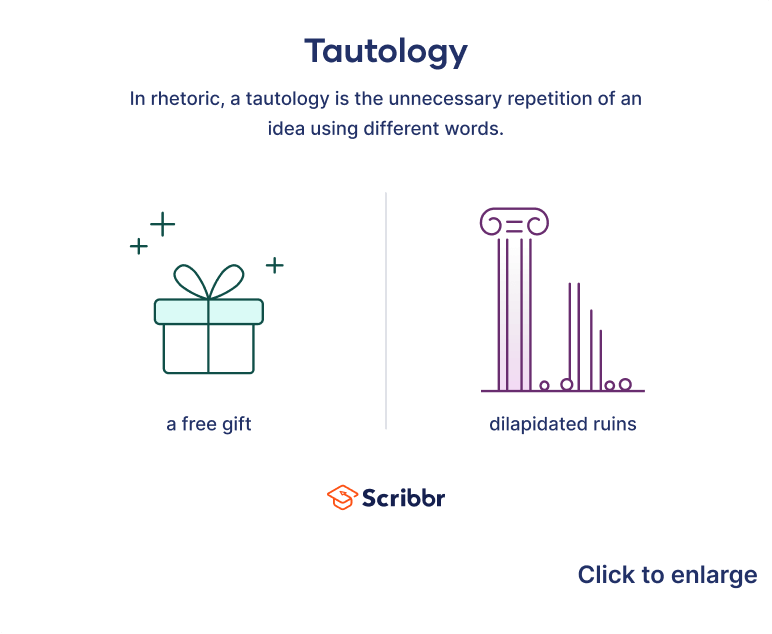Tautology | Meaning, Definition & Examples
In rhetoric, a tautology is the unnecessary repetition of an idea using different words (e.g., “a free gift”).
Tautologies are often considered to be a stylistic fault that should be avoided. However, they can also be used effectively as a rhetorical device or figure of speech.
The term may also refer to a logical tautology: a statement that is true in all circumstances because it includes all possibilities (e.g., “it will snow tomorrow or it will not”).
In my opinion, I think it’s a good book.
The party was an unexpected surprise.
The boat will depreciate in value.
Some sources try to make a distinction between the two: pleonasms repeat the inherent quality of a thing but may involve different parts of speech (e.g., “burning fire”), while tautologies involve synonyms (e.g., multiple adjectives with the same meaning: “a big, huge truck”). However, this distinction is rarely followed in practice.
Types of tautology
There are two main types of tautology. One is relevant in the context of rhetoric, the other in the context of formal logic.
Rhetorical tautology
A rhetorical tautology is the redundant restatement of an idea of concept.
Rhetorical tautologies occur when additional words are used to convey a meaning that is already expressed or implied. For example, the phrase “a new innovation” is a tautology because “innovations” are by definition “new”.
Rhetorical tautologies are usually perceived as bad style because they are needlessly repetitive. However, they can also be used to effectively emphasise a particular aspect of an idea (for this reason, they’re often used in political speeches and advertising slogans).
Have you made any future plans?
The police apprehended the armed gunman.
Logical tautology
A logical tautology is a proposition or statement that is always true because it excludes no logical possibility.
Logical tautologies don’t express any meaningful claim about the world. They usually take the form of “either/or” statements (e.g., “It will happen or it won’t”).
Some logical tautologies involve circular reasoning, meaning they support their initial claim by referring back to the claim again. In these instances, the premise is simply repeated (e.g., “blue is blue”).
You’re coming or you’re not.
The book is popular because people like it.
While logical tautologies are typically logically redundant, they’re sometimes used in a non-literal sense (often to express inevitability).
It is what it is. [i.e., the situation can’t be changed and must be accepted]
Should you avoid using tautologies?
Using tautologies is normally considered a fault of style and should be avoided in formal contexts like academic writing.
Tautologies often occur when a synonym (or a word that conveys a similar idea) is included in a sentence. In these instances, you can remove the superfluous word to make your writing more concise.
- I’m arriving at 6 a.m. in the morning. [a.m. means “in the morning”]
- I’m arriving at 6 a.m.
- I’m arriving at 6 in the morning.
- Aaron made an unintentional mistake. [mistakes are always unintentional]
- Aaron made a mistake.
- You can use the ATM machine over there. [ATM stands for “automated teller machine”]
- You can use the ATM over there.
However, tautologies are often also used effectively in literature, political speeches, advertising, and everyday speech to emphasise something or convey a sense of certainty.
For example, while the expression “I saw it with my own eyes” is tautologous (you cannot see something with someone else’s eyes), it’s commonly used to emphasise that something is true even though it seems unbelievable.
Other interesting articles
If you want to know more about language rules, AI tools, and fallacies, make sure to check out some of our other articles with explanations and examples.
Fallacies
AI
Frequently asked questions
- What is a rhetorical tautology?
-
A rhetorical tautology is the repetition of an idea of concept using different words.
Rhetorical tautologies occur when additional words are used to convey a meaning that has already been expressed or implied. For example, the phrase “armed gunman” is a tautology because a “gunman” is by definition “armed.”
- What is a logical tautology?
-
A logical tautology is a statement that is always true because it includes all logical possibilities.
Logical tautologies often take the form of “either/or” statements (e.g., “It will rain, or it will not rain”) or employ circular reasoning (e.g., “she is untrustworthy because she can’t be trusted”).
Cite this Scribbr article
If you want to cite this source, you can copy and paste the citation or click the ‘Cite this Scribbr article’ button to automatically add the citation to our free Reference Generator.
Ryan, E. (2023, October 27). Tautology | Meaning, Definition & Examples. Scribbr. Retrieved 9 December 2024, from https://www.scribbr.co.uk/rhetorical-devices/tautology-meaning/




